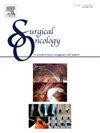在黑色素瘤和早期口腔鳞状细胞癌的前哨淋巴结活检中,基于Tilmanocept的淋巴显像是否优于胶体淋巴显像?
IF 2.4
4区 医学
Q3 ONCOLOGY
引用次数: 0
摘要
目的:网膜淋巴结活检(SLNB)在皮肤黑色素瘤和口腔鳞状细胞癌(OCSCC)中至关重要,因为它指导了全身治疗的需要。由于其特殊的结合能力,人们对锝-99m标记的Tilmanocept (TL)越来越感兴趣。本研究比较了TL和99mtc -硫化锑胶体(ASC)在这两种生物学上不同的癌症中的疗效。在这项前瞻性横断面研究中,每个放射性示踪剂组包括40名患者。主要结果是淋巴显像上的SN识别率和手术淋巴结回收率。次要结局包括淋巴结病理状态、假阴性率(FNR)和淋巴结复发率。结果与ASC结果相当,SN的检出率和回收率均为100%。两种放射性示踪剂均具有100%的淋巴结组织特异性,CM的FNR率为0%,OCSCC的TL为25%。在CM和OCSCC中,ASC的SN检出率和检索率存在显著差异,但在TL中无显著差异,说明其结合能力更强。结论本研究首次证明了TL具有较强的分子结合能力,且迁移到第二梯队节点的迁移量最小。本文章由计算机程序翻译,如有差异,请以英文原文为准。
Does Tilmanocept based lymphoscintigraphy measure up against colloid-based lymphoscintigraphy for sentinel node biopsy in melanoma and early oral squamous cell cancer?
Objective
Sentinel lymph node biopsy (SLNB) is crucial in cutaneous melanoma and oral cavity squamous cell carcinoma (OCSCC) as it directs the need for systemic therapy. There has been growing interest in Technetium-99m-labeled Tilmanocept (TL) due to its specific binding capability. This study compares the efficacy of TL to 99mTc-antimony sulphide colloid (ASC), in these two biologically distinct cancers.
Design
In this prospective cross-sectional study, 40 patients were included in each radiotracer group. The primary outcomes measured SN identification rate on lymphoscintigraphy and surgical node retrieval rate. Secondary outcomes include pathological status of lymph nodes, false negative rates (FNR), and nodal recurrence.
Result
TL had comparable outcome to ASC with a 100 % SN detection and retrieval rate. Both radiotracers had 100 % lymph nodal tissue specificity with an FNR rate of 0 % for both radiotracers in CM and 25 % for TL in OCSCC. There were significant differences between the SN detection and retrieval rates in ASC in CM and OCSCC but not TL, reflecting its superior binding capability.
Conclusion
Our study is the first to demonstrate the superior molecular binding capability of TL with minimal migration to the second echelon nodes.
求助全文
通过发布文献求助,成功后即可免费获取论文全文。
去求助
来源期刊

Surgical Oncology-Oxford
医学-外科
CiteScore
4.50
自引率
0.00%
发文量
169
审稿时长
38 days
期刊介绍:
Surgical Oncology is a peer reviewed journal publishing review articles that contribute to the advancement of knowledge in surgical oncology and related fields of interest. Articles represent a spectrum of current technology in oncology research as well as those concerning clinical trials, surgical technique, methods of investigation and patient evaluation. Surgical Oncology publishes comprehensive Reviews that examine individual topics in considerable detail, in addition to editorials and commentaries which focus on selected papers. The journal also publishes special issues which explore topics of interest to surgical oncologists in great detail - outlining recent advancements and providing readers with the most up to date information.
 求助内容:
求助内容: 应助结果提醒方式:
应助结果提醒方式:


